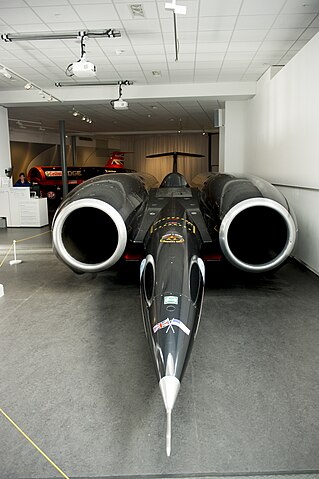
Is there a land speed record limit? Because of physics and current technology there is, but no one knows exactly what that limit is.
The current land speed record was achieved in 1997 and it is 1,223.657 km/h (760.343 mph). It was broken by a team driving a car called Thrust SuperSonic Car and the driver was Andy Green. I say driver, but at that speed he is closer to a pilot than a driver, and Andy Green was actually an RAF pilot. The car actually peaked at 1,228 km/h, but the record is the average of two runs. The car was 16.5 m long and 3.7 m wide. It has two Rolls-Royce jet engines that provided 223 kN of thrust. The car weighed 10.6 tons. It was driven on the desert in Black Rock, United States. It is the only land vehicle to have ever broken the sound barrier, which is at roughly 1,230 km/h.
That record hasn’t been broken for 27 years. Why is that? To break that land speed record, you need several things. You need money, of course. You need a flat piece of land. You need perfect weather. You need wheels that can sustain that speed. You need an engine that can provide enough thrust. And you need a fuel source and a vehicle that is light enough.
Money is almost as important as all of the other limits to beating the land speed record, although it is certainly not insurmountable. A record attempt would probably cost between $40 and $50 million. That is a lot of money, but it is certainly less than a lot of other projects that companies undertake. If the advertising was there, a company like Red Bull would probably be willing to invest that much money. There is currently a potential car called the Bloodhound that is going on sale for $11 million and that has the potential to be able to go over 1,600 km/h (1,000 mph).
So, what are the problems that need to be overcome? The biggest two problems are drag and thrust. Thrust is probably less of a problem because jets that can propel planes at far faster than these speeds currently exist. Many production fighter jets can go at more than two times faster than the current record holder. The problem is, those jets are only pushing against air and they don’t have to contend with the friction from the ground. They are also high up, where the atmosphere is thinner and easier to push through. For this to be a land speed record, the vehicle obviously has to stay on the ground. Other than improving the efficiency of the rockets, the only other way to improve thrust is by making the car lighter. That is hard to do at the moment because most of the weight is fuel. Unless a more efficient engine or a different kind of fuel are invented, the weight is not going to change.
That means drag is far more of a problem than thrust. The car encounters drag from the air and from the ground. The Bloodhound is technically a car, which means it has wheels that contact the ground, and these points of contact are going to increase the amount of friction that the car has to push against. Any friction or drag is going to reduce the effectiveness of the engines. The Bloodhound has wheels made of an aluminium-zinc alloy that weigh 95 kg each. They have to be made of soil metal because rubber tires would disintegrate at that speed. They spin at 10,000 rpm and heat up to 100℃.
The drag from the air can only be countered by making the car as aerodynamic as possible, in the same way as a plane. One difference is that a plane wants to go up and the driver of this car most definitely does not want it to go up. It is given more downforce to push it into the ground and increase its grip, but that also increases the drag. Everything is a trade off. The record attempt is also made on a day with as little wind as possible.
The ground must be perfectly flat as well. These record breaking attempts are usually made on deserts or saltflats because they have the flattest land. The problem is, even the slightest rock or hole at 1,000 mph can be deadly. Several land speed record attempts have ended in tragedy because of this. The car needs to survive vibrations from the ground that a plane would never need to.
So, how fast could a car go? There is no way of knowing. However, if cars get as fast as planes, at the Mach 2 or 3 level, the friction from the ground and the air would be so great that the car would most likely burn up unless it had cladding like the space shuttle. The wheels could also start to slip because they need friction to move and at some point the speed of the car could exceed the maximum friction of the wheels, making the car uncontrollable. Still, that is with current technology. Who knows what the future might bring. And this is what I learned today.
Image By Culture Coventry Trust – Own work, CC BY-SA 4.0, https://commons.wikimedia.org/w/index.php?curid=76521260
Sources
https://www.freethink.com/transportation/land-speed-record
https://en.wikipedia.org/wiki/Land_speed_record
https://en.wikipedia.org/wiki/ThrustSSC
https://www.wired.com/story/bloodhoud-ssc-supersonic-car-funding-administration
https://www.carandbike.com/news/the-bloodhound-a-car-that-can-travel-faster-than-sound-2780191
https://www.sciencefocus.com/qanda/top-ten-fastest-jets-in-the-world
https://www.matfoundrygroup.com/blog/Bloodhound_SSC-1000mph_Land_Speed_Record
